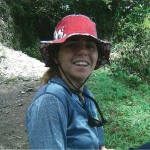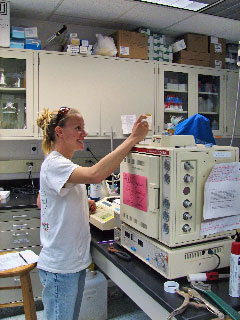Dr. Tali Mass & Ms. Jeana Drake presented their current research on the January 30, 2013 Ocean Lecture & Educators’ Night. Ms. Drake discussed how scientists use thousands of years of data and corals to look at changes in the climate over time and what corals can teach us. Following the lecture, we shared lesson plans related to corals and changes with climate over time as well as discussed how to bring these topics into your classrooms/clubs.
Below we have included a summary of Dr. Mass & Ms. Drake, Background Materials, the evening’s broadcast, the .pdf of the science presentation, and adapted Lesson Plans to teach on the topics of corals and changes with climate.
Enjoy! The East Coast MARE Team
Dr. Tali Mass –
Dr. Mass is a post-doctoral researcher at the Institute of Marine & Coastal Sciences.
Jeana Drake –
Ms. Drake is a PhD student at the Institute of Marine & Coastal Sciences under the advising of Paul Falkowski. Along with several post-docs and other scientists, she is working on characterizing the proteins found in coral skeletons. Ms. Drake and her colleagues hypothesize that these proteins play an active role in coordinating calcium and carbonate or bicarbonate ions to form the aragonite crystals that make up coral reefs.
Background Materials-
We will compile the following materials as optional background information if you wish to read about the topics that were covered during the event and included in the adapted lesson plans below.
If you are interested in watching the broadcast of the event, click here: https://www.ustream.tv/recorded/28927555 If you are interested in downloading the presentation slides, click here: Jeanna Drake and Dr. Moss’s PresentationCorals:
Changes with Climate:
Science Presentation & Evening Program-
Lesson Plans-
You Scratch My Back and I’ll Scrath Yours: Through an active class demonstration, students learn about photosynthesis in, effects of extreme temperatures on, and effects of lack of sunlight on corals. (Elementary School) Life Science: Matter & Energy Transformations – 5.3.2.B.1, 5.3.2.B.2, 5.3.2.B.3, 5.3.4.B.1 Mealtime for Corals: This activity illustrates the feeding activity of a coral colony through a hands-on demonstration by the class. Individual polyps, though connected, feed independently. (Elementary School) Life Science: Matter & Energy Transformations – 5.3.2.B.1, 5.3.2.B.2 The Edible Coral Polyp: Students will review the parts of a coral polyp by building an edible coral polyp model. (Elementary & Middle School) Life Science: Organization & Development – 5.3.2.A.1, 5.3.4.A.1, 5.3.4.A.2, 5.3.6.A.2, 5.3.8.A.1 Remote Sensing & Coral Reefs: This curriculum contains seven lesson plans about coral reef monitoring. It covers the electromagnetic spectrum, altimetry, coral reefs, symbiosis, phytoplankton, sea surface temperature, and conservation issues. Supplemental material includes two slideshows (See ‘Landlords of the Reef’ and ‘Threats for Corals’ in Videos, Slideshows, and More). (Elementary & Middle School) Science Practices: Generate Scientific Evidence Through Active Investigations – 5.1.8.B.2, 5.1.8.B.3, 5.1.8.B.4 Rate of Coral Growth: Using a data table and graphing, students will understand the growth of coral depends on water depth and the effect of sea level changes on corals. (Middle School) Science Practices: Generate Scientific Evidence Through Active Investigations – 5.1.8.B.2, 5.1.8.B.3, 5.1.8.B.4 How do Polyps Build Reefs?: Students will simulate the process that occurs when a coral polyp forms its skeleton. The demonstration will help students understand where polyps get the limestone they need to build their skeletons and the reefs. (Middle School) Physical Science: Properties of Matter – 5.2.8.A.7 Making Coral Skeletons: Through a hands-on experiment, students learn that the raw materials of coral skeletons are contained within seawater and realize that the coral polyp has the ability to extract these raw materials from sea water, and to produce a solid substance. (Middle & High School) Physical Science: Properties of Matter – 5.2.8.A.7, 5.2.12.A.5, 5.2.12.A.6 Photoquadrats on a Transect: Students use printed photographs of real coral reef sample areas, called photoquadrats, to quantitatively assess the composition and health of a coral reef. (Middle & High School) Science Practices: Generate Scientific Evidence Through Active Investigations – 5.1.8.B.2, 5.1.8.B.3, 5.1.8.B.4, 5.1.12.B.2, 5.1.12.B.3, 5.1.12.B.4 Keeping Watch on Coral Reefs: Students will learn about the benefits of and threats to corals while obtaining and analyzing several types of oceanographic data from remote-sensing satellites. The second part of the lesson has the students create public outreach programs to bring their knowledge to their peers. (High School) Science Practices: Generate Scientific Evidence Through Active Investigations – 5.1.12.B.2, 5.1.12.B.3, 5.1.12.B.4 How Does Your (Coral) Garden Grow?: Students will identify and briefly explain two methods for estimating the age of hard corals and learn how oxygen isotope ratios are related to water temperature and interpret data. (High School) Science Practices: Generate Scientific Evidence Through Active Investigations – 5.1.12.B.2, 5.1.12.B.3, 5.1.12.B.4Corals Lesson Plans:
Life Science: Interdependence – 5.3.2.C.1, 5.3.2.C.3, 5.3.4.C.1, 5.3.4.C.2
Life Science: Interdependence – 5.3.2.C.1, 5.3.2.C.3, 5.3.4.C.1, 5.3.4.C.2
Life Science: Organization & Development – 5.3.6.A.2, 5.3.8.A.1
Life Science: Interdependence – 5.3.6.C.1, 5.3.6.C.2
Life Science: Evolution & Diversity – 5.3.6.E.1, 5.3.8.E.1
Life Science: Interdependence – 5.3.6.C.1, 5.3.6.C.2
Life Science: Interdependence – 5.3.6.C.2
Life Science: Matter & Energy Transformations – 5.3.12.B.1, 5.3.12.B.5
Life Science: Interdependence – 5.3.6.C.2, 5.3.12.C.1
Life Science: Interdependence – 5.3.6.C.1, 5.3.6.C.2, 5.3.12.C.1, 5.3.12.C.2
Life Science: Interdependence – 5.3.12.C.1, 5.3.12.C.2
Earth Systems Science: Biogeochemical Cycles – 5.4.12.G.5
Physical Science: Properties of Matter – 5.2.12.A.4
Physical Science: Energy Transfer & Conservation – 5.2.12.D.5
Remote Sensing & Coral Reefs: This curriculum contains seven lesson plans about coral reef monitoring. It covers the electromagnetic spectrum, altimetry, coral reefs, symbiosis, phytoplankton, sea surface temperature, and conservation issues. Supplemental material includes two slideshows (See ‘Landlords of the Reef’ and ‘Threats for Corals’ in Videos, Slideshows, and More). (Elementary & Middle School) Life Science: Interdependence – 5.3.6.C.1, 5.3.6.C.3 Sea Surface Temperature & Coral Bleaching: Students simulate field research by using NOAA maps to determine areas in the world that are likely to be affected by coral bleaching because of sea surface temperature rise. (Elementary & Middle School) Science Practices: Generate Scientific Evidence Through Active Investigations – 5.1.4.B.2, 5.1.4.B.3, 5.1.4.B.4, 5.1.8.B.2, 5.1.8.B.3, 5.1.8.B.4 Corals Growth & Skeletons: Through observing coral images and plotting calcification data, students learn how scientists use data from multiple variables to investigate potential causes of visible differences in coral growth. Students think about how gaining a better understanding of what influences coral growth under different conditions currently can guide scientists’ predictions of future changes in coral growth due to climate change. (Late Elementary & Middle School) If you are interested in watching the lesson demonstration, click here: https://www.ustream.tv/recorded/28929103 Science Practices: Generate Scientific Evidence Through Active Investigations – 5.1.4.B.2, 5.1.4.B.3, 5.1.4.B.4, 5.1.8.B.2, 5.1.8.B.3, 5.1.8.B.4 Climate, Corals & Change: Students will be able to explain the concept of “paleoclimatological proxies,” describe how oxygen isotope ratios are related to water temperature, and interpret data to make inferences about growth rates. (Middle School) Physical Science: Properties of Matter – 5.2.8.A.1 Coral Reefs, Climate Change, and the Impacts on Human Populations: Students will examine world maps of population and coral reef locations, estimate the number of people worldwide that may be affected by declining corals, and discuss how coral reefs will be impacts by climate change and how this will affect humans. (Middle School) Life Science: Interdependence – 5.3.6.C.1, 5.3.6.C.3 Coral Cores: Ocean Timelines: Students examine coral cores to learn about ancient weather patterns in the ocean and how scientists use these data to anticipate future climate changes. (Middle & High School) Earth Systems Science: History of Earth – 5.4.12.B.2 Using Satellite Data to Forecast Bleaching Events: Knowing that a major condition that is linked to coral bleaching is unusually high water temperature, students use satellite data to investigate whether this condition occurred in the Caribbean during early Fall 2005 in four different locations. (Middle & High School) Science Practices: Generate Scientific Evidence Through Active Investigations – 5.1.8.B.2, 5.1.8.B.3, 5.1.8.B.4, 5.1.12.B.2, 5.1.12.B.3, 5.1.12.B.4 Coral Growth: Photosynthesis & Calcification: Students learn that scientists use data from multiple variables to investigate potential causes of visible differences in coral growth (photosynthesis and calcification rates, coral morphology). Students hypothesize predictions of future changes in coral growth due to climate change. (High School) Science Practices: Generate Scientific Evidence Through Active Investigations – 5.1.12.B.2, 5.1.12.B.3, 5.1.12.B.4 History’s Thermometers: Students will be able to explain the concept of paleoclimatological proxies, learn how oxygen isotope ratios are related to water temperature and interpret data to make inferences about climate change. (High School) Science Practices: Generate Scientific Evidence Through Active Investigations – 5.1.12.B.2, 5.1.12.B.3, 5.1.12.B.4 Changes with Climate Lesson Plans:
Earth Systems Science: Biogeochemical Cycles – 5.4.6.G.3
Life Science: Interdependence – 5.3.4.C.1, 5.3.6.C.1, 5.3.6.C.2
Life Science: Evolution & Diversity – 5.3.4.E.1, 5.3.4.E.2, 5.3.6.E.1, 5.3.8.E.1
Life Science: Interdependence – 5.3.4.C.1, 5.3.6.C.1, 5.3.6.C.2
Life Science: Evolution & Diversity – 5.3.4.E.1, 5.3.4.E.2, 5.3.6.E.1, 5.3.8.E.1
Life Science: Interdependence – 5.3.6.C.1, 5.3.6.C.3
Earth Systems Science: History of Earth – 5.4.8.B.2
Earth Systems Science: Biogeochemical Cycles – 5.4.6.G.3
Earth Systems Science: Climate & Weather – 5.4.6.F.1, 5.4.6.F.2, 5.4.8.F.2, 5.4.8.F.3
Earth Systems Science: Biogeochemical Cycles – 5.4.12.G.5
Life Science: Interdependence – 5.3.6.C.1, 5.3.6.C.3, 5.3.12.C.1, 5.3.12.C.2
Physical Science: Energy Transfer & Conservation – 5.2.12.D.5
Life Science: Matter & Energy Transformations – 5.3.12.B.1, 5.3.12.B.3, 5.3.12.B.5
Life Science: Interdependence – 5.3.12.C.1, 5.3.12.C.2
Earth Systems Science: Biogeochemical Cycles – 5.4.12.G.5
Physical Science: Properties of Matter – 5.2.12.A.4
Physical Science: Energy Transfer & Conservation – 5.2.12.D.5
Earth Systems Science: History of Earth – 5.4.12.B.2
Earth Systems Science: Biogeochemical Cycles – 5.4.12.G.5
Interested in lesson plans about climate change in general? Visit the Dr. Miller OLEN Climate Change Basics Lesson Plans section.


